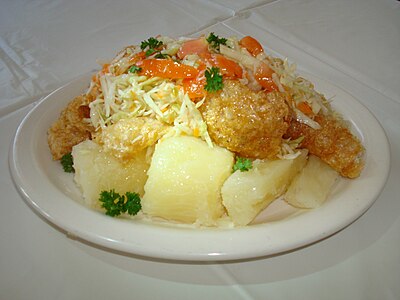
Search
Nicaraguan cuisine

Nicaraguan cuisine includes a mixture of Mesoamerican, Chibcha, Spanish, Caribbean, and African cuisine. Despite the blending and incorporation of pre-Columbian, Spanish and African influences, traditional cuisine differs from the western half of Nicaragua to the eastern half. Western Nicaraguan cuisine revolves around the Mesoamerican diet of the Chorotega and Nicarao people such as maize, tomatoes, avocados, turkey, squash, beans, chili, and chocolate, in addition to potatoes which were cultivated by the Chibcha people originating from South America and introduced meats like pork and chicken. Eastern Nicaraguan cuisine consists mostly of seafood and coconut.
Cuisine
Main staples
As in many other Latin American countries, corn is a staple. It is used in many widely consumed dishes such as nacatamal and indio viejo. Corn is not only used in food; it is also an ingredient for drinks such as pinolillo and chicha as well as in sweets and desserts. Other staples are rice and beans. Rice is eaten when corn is not, and beans are consumed as a cheap protein by the majority of Nicaraguans. It is common for rice and beans to be eaten as a breakfast dish. There are many meals including these two staples; one popular dish, gallo pinto, is often served as lunch, sometimes with eggs. Nicaraguans do not limit their diet solely to corn, rice, and beans. Many Nicaraguans have small gardens of their own full of vegetables and sometimes incorporate flowers into their meals.
Commonly used ingredients are peanuts, cabbage (shredded in vinegar, this is called "ensalada" and used as a side dish, sometimes with carrots and beets added), carrots, beets, butternut squash, plantains, bananas, fresh ginger, onion, potato, peppers, jocote, grosella, mimbro, mango, papaya, tamarind, pipian, apples, avocado, yuca, and quequisque. Herbs such as cilantro, oregano, and achiote are also used in cooking.
Typical Nicaraguan dishes
Beverages
Refrescos (drinks)
Nicaraguan cuisine makes use of fruits, some of which are only grown in that particular region due to their location. Many fruits are made into drinks known as frescos, the Nicaraguan name for what are called "aguas frescas" in other Latin American countries. Common flavors include melon, tamarind, papaya, guayaba, guanábana, coconut, pineapple, and pitahaya. Pinolillo is very popular among Nicaraguans, as many times they refer to themselves as pinoleros, which means "pinolillo drinkers". Many drinks are also made from grains and seeds, mixed with milk, water, sugar and ice.
Alcoholic beverages
Rums, such as Flor de Caña and Ron Plata (both produced by Compañía Licorera de Nicaragua, S.A (CLNSA)), are both a popularly consumed beverage in Nicaragua and a crucial export product.
Popular rum-based cocktails include the "Nica libre," a regional re-naming of the Cuba libre (itself a variation of rum and coke), and the "Macuá" (containing orange, guava, and lime juices). The "Macúa" originated in 2006, when it won a Flor de Caña-sponsored competition to determine a marketable national cocktail representing Nicaragua, and was created by a pediatrician from Granada.
Beer is also a common alcoholic beverage consumed in Nicaragua. Popular brands include Toña and Victoria, two former competitors both now produced by Compañía Cervecera de Nicaragua, as of a 1996 merger.
Other drinks
Postres (desserts)
See also
- Latin American cuisine
References
External links
- Traditional Nicaraguan food
- Nicaraguan Food recipes
Text submitted to CC-BY-SA license. Source: Nicaraguan cuisine by Wikipedia (Historical)
Owlapps.net - since 2012 - Les chouettes applications du hibou



